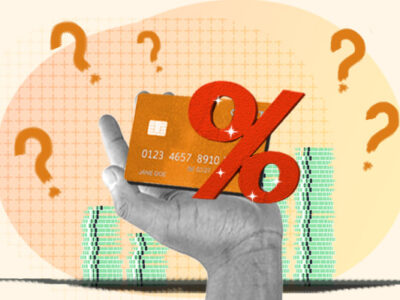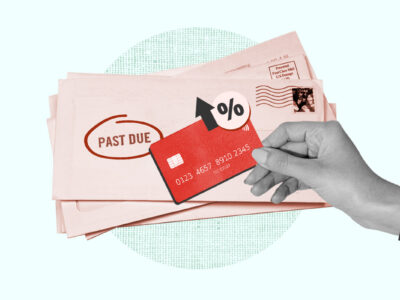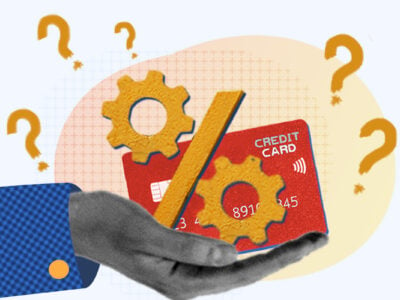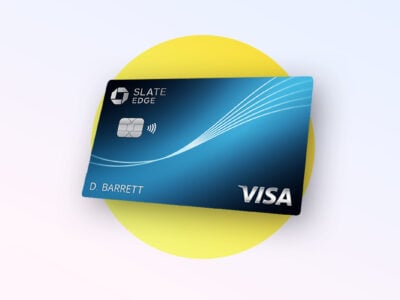Credit card terms aren’t always easy to understand. For example, credit cards list APRs instead of interest rates. Not only is APR a unique way of expressing interest rates, but there are also different types of credit card APRs and different ways that APR can be calculated.
Keep reading to learn more about what credit card APR is, how it works, and how you can lower your credit card’s APR.
Table of Contents
What is APR on a credit card?
APR stands for annual percentage rate. A credit card’s APR is the yearly rate at which unpaid balances will accrue interest on that particular card.
In other words, credit card APR is the credit card’s annual interest rate.
Credit card APR varies between cards as well as borrowers. The main factors that affect a credit card’s APR include:
- The card issuer
- The card type
- Your credit score
- Your income
- Current marketing conditions (particularly a benchmark called the prime rate)
Credit cards for people with good credit usually have lower APRs than cards for people who’ve had issues with credit in the past.
For instance, credit cards for no-credit borrowers tend to have high APRs, often ones that range between 19.99%–23.99%. If you applied for one of these cards and also have a low income or an unstable employment situation, you’ll likely get offered a card with an APR near the higher (23.99%) end of the spectrum.
While APR varies between cards and borrowers, you can gauge how good or bad a card’s APR is by looking at the current averages and the most applicable APR ranges to your borrowing situation.
What is the average credit card APR?
According to the Consumer Financial Protection Bureau, the average credit card APR is between 15%–16%. 1
However, that’s accounting for all types of credit cards on the market. Keep in mind that average APRs vary based on the type of card. For example, credit cards for bad credit, no credit, limited credit, or people who are rebuilding damaged credit tend to have higher APRs than those available to borrowers with good credit. (The average APR on credit cards available to borrowers with poor credit is probably closer to 23%.)
What is a good APR for a credit card?
What’s considered a good APR for a credit card varies depending on your financial situation, credit score, and the type of card you’re applying for. Generally speaking, a good credit card APR is one that’s below the national average—so under 15%–16%.
Again, this number doesn’t apply to everyone. For example, if you’re a borrower with a less-than-perfect credit history, aiming for an APR closer to 20% is more reasonable.
Why your credit card APR doesn’t necessarily matter
Note that you’ll only be charged interest if you leave a balance on your credit card from one month to the next. This means that if you pay your credit card balance in full each month, there’s no need to concern yourself with APR at all.
Paying your balance in full is a good habit to get into in general, but it’s especially helpful if you have poor credit, which means the credit cards you’ll qualify for will probably have high APRs.
How does APR on credit cards work?
The APR on a credit card works as the interest rate for that card. As mentioned, you only need to pay this interest rate if you carry a balance on your card past the due date.
For example, if you only make your minimum monthly payment by the due date, your remaining balance for that month will accrue interest at the rate specified by your credit card’s APR. But if you pay your bill in full by the due date, you’ll avoid credit card interest that month.
How to calculate APR on credit cards
You can find your credit card’s APR on your card offer or your most recent billing statement. You can then use your APR to calculate how much interest your credit card is costing you each month.
Calculating monthly credit card interest
You can roughly estimate your monthly interest charges with this equation:
(Monthly interest rate) x (monthly balance) = monthly interest charge
You can find your monthly rate by dividing your credit card’s APR (expressed as a decimal) by 12.
For example, if you have a credit card APR of 20% and a balance of $1,500, your interest charges for that month would be roughly $25, as shown below.
Calculating daily credit card interest
Calculating your daily interest rate will give you an even more accurate estimate of your interest charges, but it takes more time and effort. Here’s the equation for your daily interest rate:
(Daily interest rate) x (average daily balance) = daily interest charge
Performing this calculation is more involved than the first one since it requires more background work.
Getting your daily interest rate is simple: just divide your APR by 365. Calculating your average daily balance is more complex. Do it by adding up the sum of your daily credit card balances for the month in question and dividing the total by the number of days in the billing cycle (generally 28–31 days).
Example of a daily credit card interest calculation
Here’s an example of how someone might calculate their daily credit card interest rate:
Let’s say you have a credit card with an APR of 18%. You started this month’s billing cycle with a balance of $150. On Day 7, you made a purchase of $50. Then, on Day 24, you made another purchase of $100.
If your billing cycle is 30 days long, this is what your daily balance for each day would look like:
- Days 1-6 (6 days): $150
- Days 7-23 (18 days): $200 (original $150 balance + the new $50 purchase)
- Days 24-30 (7 days): $300 (original $200 balance + the new $100 purchase)
Now that you have the amounts of your daily balances, add them up. Then, divide that figure by the number of days in your billing cycle (30). Doing so will give you an average daily balance of $220.
Now calculate your daily interest rate by dividing your APR (18%) by 365 to get 0.00049.
Finally, multiply your average daily balance and daily interest rate to get $0.1078.
This number represents your daily interest charge. You can multiply by the number of days in the billing cycle (30) to estimate how much interest you would need to pay that month. In the example, you’d be charged $3.23:
What are the types of credit card APR?
When we talk about credit card APR, we’re mostly referring to “purchase APR,” which is the interest rate charged on regular purchases you make with your card. However, there are many other types of APR on credit cards.
Knowing what each APR represents is important when shopping for a new card or using your existing credit card responsibly.
Here are the different types of credit card APR:
- Purchase APR: Again, purchase APR (aka regular APR) is the rate of interest you’ll be charged on normal credit card purchases. This number denotes how much interest you’ll be charged every year on unpaid balances.
- Introductory APR: Introductory APR is a special rate offered to cardholders as an incentive to open a particular credit card. Intro APR tends to be very low (often 0%), and lasts for a period of 6–18 months on average (but sometimes lasts for up to 24 months). Lower introductory APRs are usually only offered to borrowers with good or excellent credit scores.
- Cash advance APR: Cash advance APR is the rate of interest charged on the amount you borrow through a credit card cash advance. A cash advance is when you use a credit card to take money out of an ATM. Cash advances tend to come with relatively high APRs, as well as additional fees of around 3%–5% of the transaction amount.
- Balance transfer APR: Balance transfer APR is the rate of interest charged on funds you move from one credit card to another through a balance transfer. Balance transfers are often used for debt consolidation. Similar to cash advance APRs, balance transfer APRs tend to be high, with the exception of introductory balance transfer APRs (which work the same as introductory APRs, but apply specifically to balance transfers).
- Penalty APR: A penalty APR is the rate of interest charged after you miss one or more monthly payments or otherwise violate the terms of your cardholder’s agreement. Penalty APR tends to be the highest APR on your credit card. For example, CNBC reports that the APR on certain Chase credit cards reaches 29.99% if you’re late with your payment by more than 60 days. 2
Fixed APR vs. variable APR: what’s the difference?
In addition to the types of APR mentioned above, credit card APRs are further divided into two categories: fixed and variable.
Any kind of credit card APR—from purchase to penalty—can be either fixed or variable.
Fixed APR
A fixed APR doesn’t fluctuate naturally. It only changes if you miss a payment and incur a raised APR (i.e., a penalty APR) or if the credit card issuer changes the rate under specific circumstances.
However, the latter situation is uncommon and the credit card company is legally required to notify you before your APR changes. 3
Variable APR
Variable APR fluctuates naturally based on the “prime rate.” The prime rate is a federally standardized number that’s published by the Wall Street Journal. If the prime rate goes up, so do variable APRs; if the prime rate goes down, variable APRs follow suit.
The current prime rate is 7%. Variable APRs are calculated by adding this number to the lender’s margin (generally 10%–20%).
Variable APR is the standard (most common) option among credit cards. In fact, fixed-rate cards are hard to find.
Although variable APR doesn’t offer the same stability as fixed-rate APR, it does provide the possibility of enjoying a lower APR than what you originally were offered if the prime rate goes down.
How to lower your credit card’s APR
If you’re being weighed down with too much credit card debt due to a high APR, there are several solutions you can consider.
1. Improve your credit score
Unfortunately, credit card issuers tend to offer high APRs to borrowers with poor or fair credit scores.
If you want to qualify for the best credit card offers, you’ll need to improve your credit score. If you’re a new borrower with no credit history at all, first spend some time building your credit, then shop around for more favorable offers.
2. Pay off your monthly balance
Your credit card APR won’t matter if you pay off your statement balance each month. This isn’t feasible for everyone, but it’s a great solution if you can pull it off.
Note that there’s a myth that you should leave a small balance on your credit card as part of a credit hack for boosting your score. If you’re doing this, think twice. That “hack” is probably costing you money in interest and not affecting your credit score as much as you think.
If you’re able to pay your credit card balance in full, pay it. It’s very unlikely that doing so will negatively affect your score, and you’ll never spend a penny on credit card interest.
3. Consider a balance transfer
If you have a high-APR credit card that’s making paying off your debt feel impossible, consider opening a new card with a lower APR and performing a balance transfer.
Balance transfers are meant to consolidate debt onto a lower-interest credit card to ease the burden of repayment. Balance transfers come with fees and usually require you to open a new credit card, so a balance transfer shouldn’t be your first choice for snagging a lower APR, but it’s a good option in a pinch.
4. Negotiate with your credit card issuer
If your credit card APR is proving to be a financial burden, consider calling your credit card issuer and negotiating a lower APR. While it’s not guaranteed to work, it’s a risk-free option, since the worst they can do is say no.






